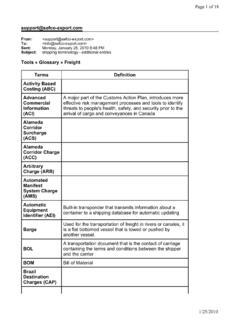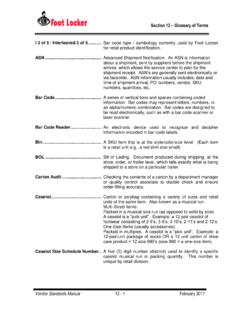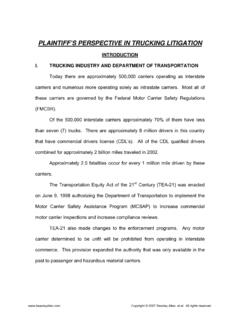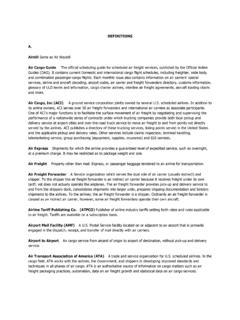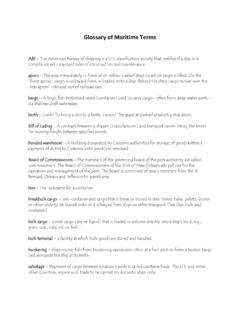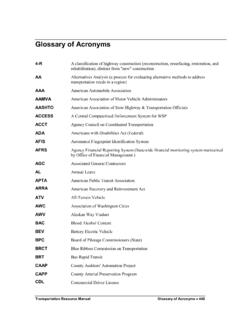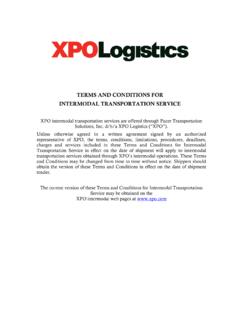Transcription of A Study of Port Truckers in Seattle - portjobs.org
1 BIG RIG, SHORT HAUL A Study of Port Truckers in Seattle Acknowledgements Many individuals who work in the freight movement system provided information to help us understand how the system works, the role of truck drivers, their working conditions, and their concerns. Our thanks to all of the drivers, trucking company representatives, and others we interviewed. We are grateful for the insights and information shared with us. Thanks to all of the following for graciously sharing their time and knowledge: Daniel Ajeto, Fast Pitch trucking Mac Gaddie, Eagle Marine Services/Terminal 5 Joey Arnold, SSA Terminals/Terminal 18 Dan Gatchet, West Coast trucking Charles Babers, Union Pacific Railroad Dennis Gustin, BNSF Railway Company Rich Berkowitz, Transportation Institute Al Hobart, International Brotherhood of Teamsters Rick Blackmore, Total Terminals Int l/Terminal 46 Beverly Null, APL Bob Blanchet, International Brotherhood of Teamsters Steve Stivala, MacMillan-Piper Shaw Canale, Shorebank Enterprise Cascadia Solange Young, MOL America Rick Catalani, Expeditors International Herald Ugles, International Longshore Workers Union Richard Dick Ford, WA State Transportation Commission Stephen Wilson, Western Ports Transportation From the Port of Seattle .
2 Mic Dinsmore, CEO during Study period Linda Styrk, Manager, Seaport Strategic Planning Steve Queen, Marketing Manager, Containers Herman Wacker, Director of Labor Relations The drivers who completed our survey and those who participated in our interviews and focus group. Finally, thanks to Kristen Monaco and Lisa Grobar of the Department of Economics at California State University, Long Beach, for their report, A Study of Drayage at the Ports of Los Angeles and Long Beach. Their survey instrument was used as the basis for Port Jobs survey of truck drivers at the Port of Seattle . Any errors in this report are the responsibility of Port Jobs. Port Jobs is a non-profit action tank working to increase access to living wage jobs for all residents of the Greater Seattle area.
3 We foster a more vibrant and equitable economy throughout King County. We engage in innovative research to develop practical, targeted programs that make good jobs easier to get and good employees easier to find in areas such as airport employment, transportation-to-work, and the skilled trades. For more information, visit the Port Jobs website: . Cover Photo by Don Wilson, Courtesy of Port of Seattle Port Jobs 2007 1 TABLE OF CONTENTS EXECUTIVE SUMMARY_____ 3 THE INTERMODAL FREIGHT SYSTEM_____ 9 Cost of shipping intermodal freight_____ 10 Types of trucking jobs_____ 13 trucking : AN OVERVIEW_____ 13 Business costs_____ 14 Skills required_____ 15 The local trucking industry_____ 17 PORT Truckers IN SEATTLE_____ 19 FINDINGS AND ANALYSIS_____ 23 Economic issues_____ 23 Environmental & safety issues_____ 33 Social issues_____ 39 RECOMMENDATIONS_____ 45 APPENDICES_____ 45 Appendix 1 glossary of trucking Related terms and Acronyms_____ 51 Appendix 2 Truck Driver Survey_____ 53 Appendix 3 Survey Results_____ 57 Appendix 4 Bibliography_____ 71 Appendix 5 Commercial Drivers Licenses_____ 73 Appendix 6 Organizing_____ 77 Appendix 7 trucking -Related Organizations and Associations_____ 79 Appendix 8 Pollution Reduction Programs at the Port of Seattle_____ 81 EXECUTIVE SUMMARY 2
4 BIG RIG, SHORT HAUL: A Study of Port Truckers in Seattle You need trucks to move things, and this isn t a very attractive industry. If volume grows like they say, how are we going to move it? - trucking company representative EXECUTIVE SUMMARY Port Jobs 2007 3 If your image of truck driving is of an eighteen-wheeler speeding down America s wide-open highways, think again. Since the heyday of CB radios and the popular radio song Convoy, interstate commerce has been deregulated, and a global explosion of intermodal freight has changed the way goods move around the world. Economic fundamentals of the trucking industry have changed, and along with them the composition of the truck driving workforce.
5 Short-haul Truckers based at America s ports now make up a large and growing portion of the country s truck driving workforce. The volume of cargo moving through Puget Sound ports makes truck drivers critical to the Seattle area economy. One quarter of Washington jobs are tied to international trade. In 2005, both the Port of Seattle and the Port of Tacoma joined an elite group of global ports that handle more than two million cargo containers per Both the amount of freight moving through Puget Sound ports and the number of trucks on the roads are expected to increase into the foreseeable future. Truck drivers are a critical link in the international freight distribution system.
6 A single ocean liner may move several thousand 1 Data provided by the Port of Seattle and Port of Tacoma websites. See Bibliography for full addresses. containers from Shanghai to Seattle . A single train may carry several hundred double-stacked containers from Seattle to Chicago. Each of those containers requires a truck and a driver to move between the Port of Seattle terminals and the railyard. Stakeholders reported that in recent years, during the high shipping season of July to October, these drivers have been in short supply. We need to get truck drivers who are here for the long term. -Railroad company representative Seasonal driver shortages have been compounded by attrition in the workforce.
7 In some cities, work slowdowns or walkouts have occurred. Within the past ten years, West Coast shippers have begun to experience delays in the movement of goods, in part because trucking companies could not find enough drivers during periods of high demand. Trade publications began openly discussing driver shortages and pay rates. While truck driving used to be a fairly lucrative field, where workers with limited education and training could earn middle-class wages and benefits, conditions have shifted dramatically over the last 25 years. We undertook this Study to determine whether there will be enough drivers to meet EXECUTIVE SUMMARY EXECUTIVE SUMMARY 4 BIG RIG, SHORT HAUL: A Study of Port Truckers in Seattle labor demand in the future, whether port-related truck driving jobs are a viable opportunity for local workers, and to assess the training needs in this industry.
8 I like the freedom of being my own boss. -Owner-operator Research Design We interviewed nineteen company stakeholders in the freight system, including representatives of trucking companies, terminal operators, steamship lines, railroads, and freight brokers; Port of Seattle officials; and local leaders of both the Teamsters and the International Longshore Workers Union (ILWU). We also interviewed nine short-haul owner-operators. In order to maintain confidentiality, we do not attribute specific statements and quotes to specific individuals in this report. We also distributed a survey to 277 Truckers at the Port of Seattle , with a response rate of 60%.
9 2 The Port Jobs survey was based on a survey developed and administered by Kristen Monaco and Lisa Grobar of the Department of Economics at California State University, 2 Response rate = the number of completed surveys returned divided by the number distributed. This response rate can be compared to the 35% refusal rate in the Monaco and Grobar Study . Long Beach, A Study of Drayage at the Ports of Los Angeles and Long Drivers were asked to identify themselves as primarily driving: Short-haul (to railheads), Delivery in Washington State, Delivery in the Seattle area, or Over-the-Road (long-haul). Following Monaco and Grobar s methodology, all drivers who did not select Over-the-Road (long-haul) were grouped together as short-haul truck drivers.
10 This gave us a total of 147 short-haul drivers. Unless otherwise indicated, all survey data in this report refers to those short-haul drivers. Many respondents did not answer every question. In reporting the data for each question, we gave the percent of those who answered the question. For example, of the 147 short-haul drivers who completed a survey, 136 identified their race/ethnicity. Of those, 71 were white. Therefore, we reported that 52% of respondents were white. For more information on the survey methodology, see Appendix 3, Survey Results. Demographic Findings Our survey found that the average short-haul driver working at the Port of Seattle is an 3 See Bibliography.
